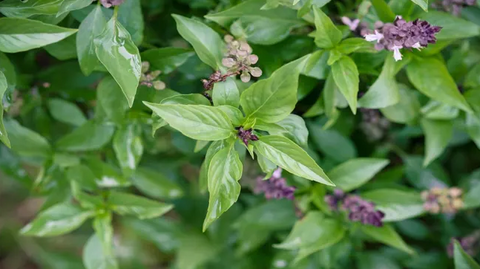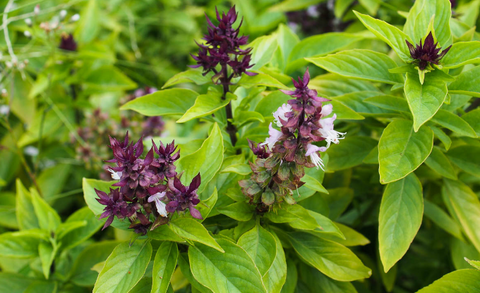Basil, with its aromatic leaves, is a delightful herb known for its versatility. This compact plant thrives outdoors in the ground, in containers, or even on a sunny kitchen windowsill. Whether you're starting from seeds indoors or growing from small pots, mastering the art of planting, cultivating, and harvesting basil will enhance your culinary adventures.

About Basil
Belonging to the mint family (Lamiaceae), basil stands as one of the most beloved culinary herbs. It's an annual herb that thrives in warm weather, making it ideal for planting once temperatures consistently exceed 50°F.
Typically, basil isn't directly seeded into the soil; instead, gardeners opt for transplanting small starter plants obtained from nurseries or grow their own seeds indoors under grow lights.
Common or sweet basil, scientifically known as Ocimum basilicum, reigns as the most prevalent variety. Other notable types include purple basil, boasting a less sweet profile, lemon basil with its citrusy essence, and Thai basil, offering a subtle hint of licorice.

If your culinary endeavors involve pesto-making, consider cultivating multiple basil plants. However, for other purposes, one or two plants should yield an ample supply.
Planting
For optimal growth, basil thrives in locations basking in 6 to 8 hours of full sunlight daily, although it can tolerate partial sun conditions.
The soil should be moderately fertile, moist yet well-draining. Raised beds are excellent choices as they facilitate better drainage. Aim for a soil pH ranging from 6.0 to 7.5 (slightly acidic to neutral).
If you intend to use basil in cooking, ensure you plant it in clean soil without the use of insecticides. Additionally, position them away from driveways and busy streets to avoid exposure to exhaust fumes.
When to Plant Basil
To jumpstart the growing season, initiate seed germination indoors 6 to 8 weeks before transplanting outside, considering your local frost dates.
For outdoor planting, wait until the soil warms to at least 50°F (10°C), preferably around 70°F (21°C) for optimal growth. Nighttime temperatures should not dip below 50°F (10°C).
Exercise patience with basil planting; without adequate warmth, the plant's growth may be stunted.

How to Plant Basil
If sowing seeds directly into the ground, plant them no deeper than 1/4-inch. Expect germination within 5 to 7 days. Once seedlings develop 2 to 3 pairs of true leaves, proceed with transplanting.
When planting germinated seedlings or starter plants, space them 10 to 12 inches apart, with basil typically reaching heights of 12 to 24 inches.
Applying a 2- to 3-inch layer of compost or shredded leaves helps retain soil moisture and suppresses weed growth.
Consider planting tomatoes alongside basil, as they make excellent companions both in the garden and on the plate.
Cultivation
How to Cultivate Basil
Maintain consistently moist soil, as basil plants thrive in moisture-rich environments.
In hot climates, apply mulch around plants to retain moisture and suppress weed growth.
During dry spells in summer, ensure plants receive ample watering.
After seedlings produce their initial six leaves, prune above the second set to encourage branching, resulting in increased leaf production.
Once branches develop six to eight leaves, repeat the pruning process back to the first set of leaves.
Fertilize sparingly throughout the season with a 5-10-5 fertilizer blend.
Approximately six weeks after planting, pinch off the central shoot to prevent premature flowering. Remove any flowers promptly.
In anticipation of cold weather or imminent frost, harvest basil beforehand to prevent damage from freezing temperatures.
Recommended Varieties
Consider incorporating different basil varieties to enhance culinary experiences:
Cinnamon basil, to add a hint of cinnamon to a dish
Purple basil adds some nice color to your garden (when steeped in white vinegar, it creates a beautiful color)
Thai basil adds a sweet licorice flavor to a dish.
Harvesting
How to Harvest BasilBegin harvesting basil leaves once plants reach 6 to 8 inches in height.
As temperatures rise to 80°F (27°C) and above, basil will flourish, producing abundant foliage.
Opt for early morning harvests when leaves are at their juiciest.
Regularly pick leaves to stimulate continual growth throughout the summer season.
Even if immediate use isn't required, harvest leaves to encourage plant vitality. Store surplus leaves for later use.
With regular harvesting, twelve basil plants can yield 4 to 6 cups of leaves per week.
Storage

The most effective storage method for basil is freezing, which preserves flavor. Quick-freeze whole or chopped leaves in airtight, resealable plastic bags before placing them in the freezer.
Alternatively, dry basil leaves for storage, though some flavor may be lost in the process. Pinch off leaves at the stem and air-dry them in a well-ventilated, shaded area. If necessary, finish drying them in the oven on the lowest heat setting with the door slightly ajar, ensuring to rotate the leaves for even drying. Monitor them closely to prevent over-drying.









